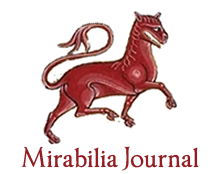Marin Marais (1656-1728). From cobbler to king’s musician
Kristina AUGUSTIN
Original title: Marin Marais (1656-1728). De sapateiro a músico do rei
Published in Music in Middle Ages and Early Modernity
Keywords: Bass Viol, French Baroque Music, Historically Informed Performance, Viola da Gamba.
The main purpose of this article is to provide a short biography about Marin Marais in Portuguese. The information gathered is not unpublished and was based on articles and books available. The main contribution of this article was to find and verify the citation of primary sources that are often not mentioned or cited in the wrong way.
Mariology, Queenship and Power in Isabel de Villena. A Female Political Theory of the 15th Century
María del Mar GRAÑA CID
Original title: Mariología, reginalidad y poder en Isabel de Villena. Una teoría política femenina del siglo XV
Published in Isabel de Villena (1430-1490)
Keywords: Female Humanism, Isabel the Catholic, Mariology, Queenship, Querelle des femmes, Virtues.
Isabel de Villena, author of Humanism, offers a female paradigm of government in her Vita Christi: The Virgin Mary as queen and as pope. Through queenship, she formulates a new political ethic that she presents as a model to power male holders. Its study confirms the participation of the author in the “Querelle of Femmes” and show coincidences with contemporary courts of queens like Isabel I.
Medical student's evaluation about use of eponyms in medical practice
Fleury Marinho da SILVA, Rodolfo Costa SYLVESTRE, José Guilherme Pinheiro PIRES
Original title: Avaliação dos estudantes de medicina sobre o uso de epônimos na prática médica
Published in
Keywords: Eponyms, Medical Education, Terminology.
Eponym is a terminology created from a person’s name for naming syndromes, signs or diseases. Several authors argue against the use of eponyms, yet some support their use. Our objective is to evaluate the opinion of medical students about the use of eponyms in medical practice. A qualitative research was done with students from 3rd to 5th year of a southeastern Brazilian medical school, through the application of a questionnaire, interview recording, and transcript of the answers. The qualitative analysis was done using the evocations of the subjects under study. The majority of the students was against the use of these nomenclatures, both in medical practice and in basic training. The students argued the difficulty for memorizing the names and obstacles in communication when using the eponyms. However, they also remember that the use of eponyms is frequently a tribute to the first physicians in history and its use is already common in the academic and professional environments. A major debate among medical educational institutions and students should be considered for probable adjustments of the difficulties that students have faced in their undergraduate period concerning the use of eponyms.
Medieval Misogyny and its echoes in the Lais of Marie de France
Ruy de Oliveira ANDRADE FILHO, Ligia Cristina CARVALHO
Original title: A misoginia medieval e seus ecos nos Lais de Maria de França
Published in Mulier aut Femina. Idealism or reality of women in the Middle Ages
Keywords: Chivalric literature, Female images, Maria of France, Misogyny.
The Lais of Marie de France are a specific type of historical record about the medieval aristocratic society and enables us to decipher the hierarchies that govern the relationship between men and women in the period. As well explains Georges Duby, medieval society tends to present coated with a male character because, among other factors, its latent misogyny. Women were placed under male authority, convinced of their natural superiority , the men despised , mocked her sex , meanwhile feared them, after all, women were Eve’s daughters. So, Lais offer female images that cannot be ignored , since it express the author women’s idea. However , as we seek to demonstrate in this article, Maria of France reflects the representations of the Christian society aristocratic. One note here that this article does not aspire to reach the actual circumstances, but the historical significance of female images present in the Lais.
Medieval art, the longing for beauty and the fourth way of St. Thomas Aquinas
Armando Alexandres dos SANTOS
Original title: A arte medieval, o anseio pela beleza e a quarta via de São Tomás de Aquino
Published in
Keywords: Evidences of the existence of God, Longing for beauty, Medieval Art, Pulchritudinis via, St. Thomas Aquinas.
This article focuses on the fourth way of St. Thomas Aquinas (1225-1274) for the rational demonstration of the existence of God (the way of degrees of perfection) from the specific point of view of the continuous search, in everything, of beauty as an ideal of religious inspiration, in the art and life of the medieval people.
Medieval images in Argentine textbooks
Laura C. del VALLE, David WAIMAN
Original title: Las imágenes medievales en los manuales escolares argentinos
Published in
Keywords: Federal Law of Education, Images, Middle Ages, Textbooks.
Addressing the Argentine textbooks and their relationship with the iconic aspects, proposes in a well-defined period, which is the implementation of the Federal Law of Education since 1993 until 2006. This research aims to investigate some quantitative and qualitative aspects about images of medieval period textbooks of Social Sciences, deepening the comparative analysis between two of the big publishers nationwide, Santillana and Kapelusz.
Medieval leprosy and the metaphorical medicine of Ramon Llull (1232-1316)
Ricardo da COSTA; Hélio ANGOTTI-NETO
Original title: Medieval leprosy and the metaphorical medicine of Ramon Llull (1232-1316)
Published in
Keywords: History of Medicine, Leprosy, Middle Ages.
A brief study of leprosy in the Middle Ages, its history, medical perception and social attitude toward manifestations of the disease. As a case study about the prevailing medical principles, we present some excerpts from Començaments de Medicina (c.1274-1283), Doctrina pueril (c. 1274-1276), Fèlix o Libre de Maravelles (1288-1289), and Liber prouerbiorum (c. 1296) by the medieval philosopher Ramon Llull (1232-1316). It presents the theoretical foundations of his Medicine: a metaphorical art that links the Hippocratic four elements (air, fire, earth and water) and Christian Theology using numeric symbolism.
Mediterranean Cultural Tensions in Roman Egypt in light of the Λόγος Τέλειος (III AD)
David Pessoa de LIRA
Original title: Tensões mediterrâneas culturais no Egito Romano à Luz do Λόγος Τέλειος (III AD)
Published in Intercultural Mediterranean
Keywords: Asclepius Latinus, Hermetic Literature, Native Egyptians, Sociopolitical and socioreligious tensions, Λόγος Τέλειος, ἀλλόφυλοι, ⲗⲟⲅⲟⲥ ⲧⲉⲗⲉⲓⲟⲥ.
Language:
The Mediterranean in the Ancient Age was a space of conflicts, exchanges, encounters, interactions and disagreements. This article examines the cultural tensions between native Egyptians (ⲛ̅ⲣⲙ̅ⲛ̅ⲕⲏⲙⲉ [enremenkēme]) and the settlers of the metropolitan nomos in Roman Egypt, known as ἀλλόφυλοι or ⲛⲁⲗⲗⲟⲫⲩⲗⲟⲥ [n.allophylos], from a historical-literary and cultural perspective. The study focuses on the predictions of the Λόγος Τέλειος, corresponding to Asclepius 24 in its Latin version and ⲗⲟⲅⲟⲥ ⲧⲉⲗⲉⲓⲟⲥ (Nag Hammadi VI.8 [70.3-71.29]) in its Coptic version, with particular emphasis on sociocultural interaction in Roman Egypt.
Membership marks. The worshipers of Dionysus and her sensory traces
María Cecilia COLOMBANI
Original title: Las marcas de la pertenencia. Las adoradoras de Dioniso en las huellas sensoriales
Published in Senses and sensibilities in classical and medieval worlds
Keywords: Bacchae, Bodies, Movement, Sensory marks.
The work traces the marks of the Dionysian thiasos as it appears in The Bacchae 1-134, fundamentally attending the relevant news of the choir. We do it from a theoretical installation model that seeks to relieve the sensory marks present in the Dionysian phenomenon. The polysemy of the god's thiasos as a moment of approach and fusion with the divinity provides us with a series of sensory elements of extreme wealth. Our project is to show how this body sensorial impacts two fundamental brands: strength and movement. The living body of the bacchante is movement captured from a visual dimension that, not only the texts but also the attic ceramic vessels, have helped to recreate from what we could call a visual metaphor. The visual impact of the ménade reflects a flexible, frantic body of ecstatic possession. The images we will analyse impact the view from its polysemy significance. The head, the torso, the hair, the feet, constitute the network of images that enter into a game of multiple meanings, which constitute the essence of Dionism. The ritual that unfolds in the festive dimension summons a second sensory mark: the auditory one. Indeed, festive excitement and divine possession generate a loudness that floods the tragic stage. From the Dioniso Bromio brand itself, which refers to the bellow of the god, to the musical instruments of dance, the sound accompanies the closeness of the god and his faithful within the framework of an auditory metaphor of marked symbolic repercussion.
Messiah seeds: routes of the Iberian royal messianism (XIV-XVI centuries)
Jacqueline HERMANN
Original title: Sementes do Messias: percursos do messianismo régio ibérico (sécs. XIV-XVI)
Published in Medieval and Early Modern Iberian Peninsula Cultural History
Keywords: Iberian Peninsula, Judaism, Messianism, Sebastianism.
This paper discusses some of the possible routes of royal messianism in the Iberian world between the XIV and XVI Centuries. Through a vast songbook, poems and texts of various kinds it is possible to identify the roots of royal messianism as emerged in Iberia Peninsula in the Middle Ages, and its development in the Modern Period. The best example of royal messianic expectations, Portuguese Sebastianism, fed upon these sources amongst others, and found fertile ground in the dramatic political context which followed the defeat by the Moors in Alcácer Quibir.






















































































